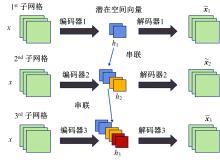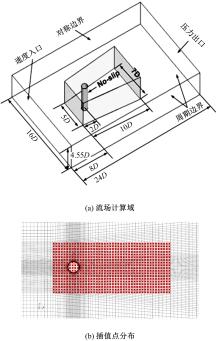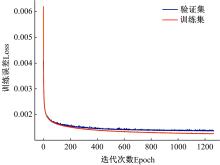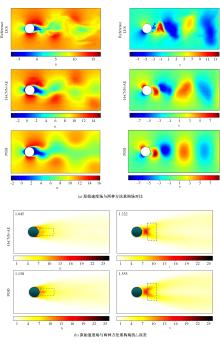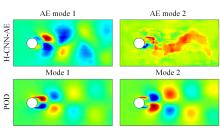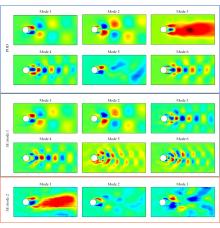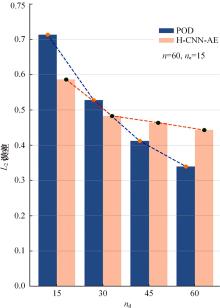Journal of Jilin University(Engineering and Technology Edition) ›› 2024, Vol. 54 ›› Issue (4): 874-882.doi: 10.13229/j.cnki.jdxbgxb.20220611
Previous Articles Next Articles
Reduced-order modelling of a bluff body turbulent wake flow field using hierarchical convolutional neural network autoencoder
Chao XIA1,2( ),Meng-jia WANG1,2,Jian-yue Zhu3(
),Meng-jia WANG1,2,Jian-yue Zhu3( ),Zhi-gang YANG1,2,4
),Zhi-gang YANG1,2,4
- 1.School of Automotive Studies,Tongji University,Shanghai 201804,China
2.Shanghai Automotive Wind Tunnel Center,Tongji University,Shanghai 201804,China
3.Institute of Rail Transit,Tongji University,Shanghai 201804,China
4.Beijing Aeronautical Science & Technology Research Institute,Beijing 102211,China
CLC Number:
- U462
| 1 | Muralidhar S D, Podvin B, Mathelin L, et al. Spatio-temporal proper orthogonal decomposition of turbulent channel flow[J]. Journal of Fluid Mechanics, 2019(864): 614-639. |
| 2 | Krizhevsky A, Sutskever I, Hinton G E. Imagenet classification with deep convolutional neural networks[J]. Advances in Neural Information Processing Systems, 2012(25): 1097-1105. |
| 3 | Hinton G, Deng L, Yu D, et al. Deep neural networks for acoustic modeling in speech recognition: The shared views of four research groups[J]. IEEE Signal Processing Magazine, 2012, 29(6): 82-97. |
| 4 | Karpathy A, Toderici G, Shetty S, et al. Large-scale video classification with convolutional neural networks[C]//Proceedings of the IEEE Conference on Computer Vision and Pattern Recognition,Columbus,USA,2014: 1725-1732. |
| 5 | Silver D, Schrittwieser J, Simonyan K, et al. Mastering the game of go without human knowledge[J]. Nature, 2017, 550(7676): 354-359. |
| 6 | 叶舒然, 张珍, 王一伟,等. 基于卷积神经网络的深度学习流场特征识别及应用进展[J]. 航空学报, 2021, 42(4):185-199. |
| Ye Shu-ran, Zhang Zhen, Wang Yi-wei, et al. Progress in deep convolutional neural network based flow field recognition and its applications[J]. Acta Aeronautica et Astronautica Sinica, 2021, 42(4):185-199. | |
| 7 | Kutz J N. Deep learning in fluid dynamics[J]. Journal of Fluid Mechanics, 2017(814):1-4. |
| 8 | Ling J, Kurzawski A, Templeton J. Reynolds averaged turbulence modelling using deep neural networks with embedded invariance[J]. Journal of Fluid Mechanics, 2016(807):155-166. |
| 9 | Lecun Y, Bottou L, Bengio Y, et al. Gradient-based learning applied to document recognition[J]. Proceedings of the IEEE, 1998, 86(11): 2278-2324. |
| 10 | Hinton G E, Salakhutdinov R R. Reducing the dimensionality of data with neural networks[J]. Science, 2006, 313(5786): 504-507. |
| 11 | Kai F, Fukagata K, Taira K. Super-resolution reconstruction of turbulent flows with machine learning[J]. Journal of Fluid Mechanics, 2019( 870):106-120. |
| 12 | 叶舒然, 张珍, 宋旭东,等. 自动编码器在流场降阶中的应用[J]. 空气动力学学报, 2019, 37(3):498-504. |
| Ye Shu-ran, Zhang Zhen, Song Xu-dong, et al. Applications of autoencoder in reduced-order modeling of flow field[J]. Acta Aerodynamica Sinica, 2019, 37(3):498-504. | |
| 13 | Omata N, Shirayama S. A novel method of low-dimensional representation for temporal behavior of flow fields using deep autoencoder[J]. AIP Advances, 2019, 9(1):No.015006. |
| 14 | Murata T, Kai F, Fukagata K. Nonlinear mode decomposition with convolutional neural networks for fluid dynamics[J]. Journal of Fluid Mechanics, 2020, 882: No.A13. |
| 15 | Kai F, Hasegawa K, Nakamura T, et al. Model order reduction with neural networks: application to laminar and turbulent flows[J].SN Computer Science, 2021, 2(6):No.467. |
| 16 | Kai F, Nakamura T, Fukagata K. Convolutional neural network based hierarchical autoencoder for nonlinear mode decomposition of fluid field data[J]. Physics of Fluids, 2020, 32(9):No.95110. |
| 17 | 杜祥波, 陈少强, 侯靖尧,等. 基于卷积神经网络的钝体尾迹识别研究[J]. 力学学报, 2022,54(1):59-67. |
| Du Xiang-bo, Chen shao-qiang, Hou jing-yao, et al. Wake recognition of a blunt body based on convolutional neural network[J]. Theoretical and Applied Mechanics, 2022,54(1):59-67. | |
| 18 | Le Q, Ngiam J, Chen Z, al et, Tiled convolutional neural networks [J]. Adv Neural Inf Proc Syst,2010,23:1279-1287. |
| 19 | Saegusa R, Sakano H, Hashimoto S. Nonlinear principal component analysis to preserve the order of principal components[J]. Neurocomputing, 2004,61:57-70. |
| 20 | Chu S J, Xia C, Wang H F, et al. Three-dimensional spectral proper orthogonal decomposition analyses of the turbulent flow around a seal-vibrissa-shaped cylinder[J]. Physics of Fluids, 2021, 33(2):No.25106. |
| 21 | Sirovich L. Turbulence and the dynamics of coherent structures. I. Coherent structures[J]. Quarterly of Applied Mathematics, 1987, 45(3): 561-571. |
| [1] | Guo-jun YANG,Ya-hui QI,Xiu-ming SHI. Review of bridge crack detection based on digital image technology [J]. Journal of Jilin University(Engineering and Technology Edition), 2024, 54(2): 313-332. |
| [2] | Xiang-jiu CHE,Huan XU,Ming-yang PAN,Quan-le LIU. Two-stage learning algorithm for biomedical named entity recognition [J]. Journal of Jilin University(Engineering and Technology Edition), 2023, 53(8): 2380-2387. |
| [3] | Zhen-hai ZHANG,Kun JI,Jian-wu DANG. Crack identification method for bridge based on BCEM model [J]. Journal of Jilin University(Engineering and Technology Edition), 2023, 53(5): 1418-1426. |
| [4] | Pei-yong LIU,Jie DONG,Luo-feng XIE,Yang-yang ZHU,Guo-fu YIN. Surface defect detection algorithm of magnetic tiles based on multi⁃branch convolutional neural network [J]. Journal of Jilin University(Engineering and Technology Edition), 2023, 53(5): 1449-1457. |
| [5] | Feng-le ZHU,Yi LIU,Xin QIAO,Meng-zhu HE,Zeng-wei ZHENG,Lin SUN. Analysis of hyperspectral image based on multi-scale cascaded convolutional neural network [J]. Journal of Jilin University(Engineering and Technology Edition), 2023, 53(12): 3547-3557. |
| [6] | Hai-long GAO,Yi-bo XU,De-zao HOU,Xue-song WANG. Short⁃term traffic flow prediction algorithm for road network based on deep asynchronous residual network [J]. Journal of Jilin University(Engineering and Technology Edition), 2023, 53(12): 3458-3464. |
| [7] | Jun-jie WANG,Yuan-jun NONG,Li-te ZHANG,Pei-chen ZHAI. Visual relationship detection method based on construction scene [J]. Journal of Jilin University(Engineering and Technology Edition), 2023, 53(1): 226-233. |
| [8] | Xuan-jing SHEN,Xue-feng ZHANG,Yu WANG,Yu-bo JIN. Multi⁃focus image fusion algorithm based on pixel⁃level convolutional neural network [J]. Journal of Jilin University(Engineering and Technology Edition), 2022, 52(8): 1857-1864. |
| [9] | Ming-hua GAO,Can YANG. Traffic target detection method based on improved convolution neural network [J]. Journal of Jilin University(Engineering and Technology Edition), 2022, 52(6): 1353-1361. |
| [10] | Huai-jiang YANG,Er-shuai WANG,Yong-xin SUI,Feng YAN,Yue ZHOU. Simplified residual structure and fast deep residual networks [J]. Journal of Jilin University(Engineering and Technology Edition), 2022, 52(6): 1413-1421. |
| [11] | Xue-zhi WANG,Qing-liang LI,Wen-hui LI. Spatio⁃temporal model of soil moisture prediction integrated with transfer learning [J]. Journal of Jilin University(Engineering and Technology Edition), 2022, 52(3): 675-683. |
| [12] | Xiang-jun LI,Jie-ying TU,Zhi-bin ZHAO. Validity classification of melting curve based on multi⁃scale fusion convolutional neural network [J]. Journal of Jilin University(Engineering and Technology Edition), 2022, 52(3): 633-639. |
| [13] | Xian-tong LI,Wei QUAN,Hua WANG,Peng-cheng SUN,Peng-jin AN,Yong-xing MAN. Route travel time prediction on deep learning model through spatiotemporal features [J]. Journal of Jilin University(Engineering and Technology Edition), 2022, 52(3): 557-563. |
| [14] | Wen-zhi GAO,Yan-jun WANG,Xin-wei WANG,Pan ZHANG,Yong LI,Yang DONG. Real⁃time diagnosis for misfire fault of diesel engine based on convolutional neural network [J]. Journal of Jilin University(Engineering and Technology Edition), 2022, 52(2): 417-424. |
| [15] | Long ZHANG,Tian-peng XU,Chao-bing WANG,Jian-yu YI,Can-zhuang ZHEN. Gearbox fault diagnosis baed on convolutional gated recurrent network [J]. Journal of Jilin University(Engineering and Technology Edition), 2022, 52(2): 368-376. |
|
||


